How To Clean Different Types Of Outdoor Furniture?
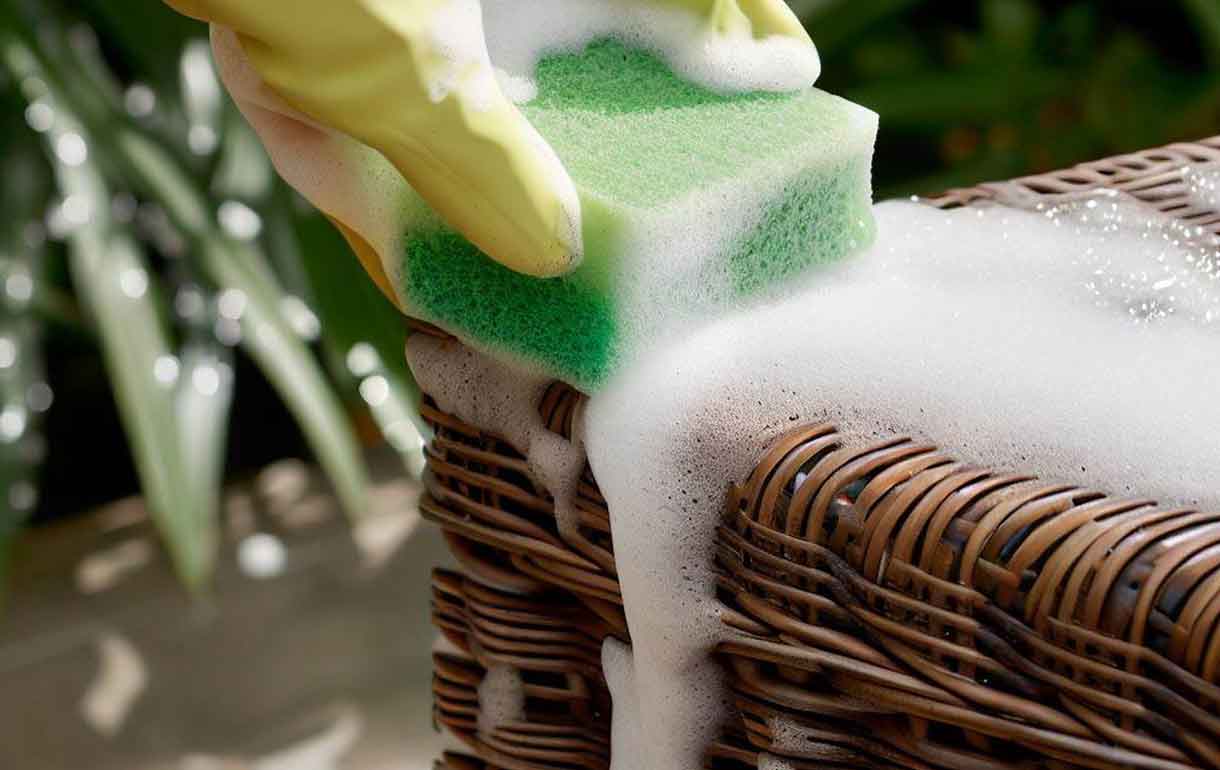
Updated: 21/06/25
Outdoor furniture is a great way to transform your outdoor area into a comfortable extension of your home. However, garden furniture can quickly collect dust and dirt as it is left exposed to the elements making cleaning and maintenance a crucial part of ownership. Choosing the right materials can save you a lot of time and effort in the future. Garden furniture should be about relaxing, not fussy cleaning methods.
In our experience, most high quality garden furniture is pretty easy to keep clean if you do it regularly. Smooth surfaces such as wood, ceramic and metal are easy to wipe clean and dry. waterproof fabric outdoor furniture such as cushions can also be cleaned this way, especially if they are water and/or stain proof. Pieces of food, trapped in rattan weave and the corners of your furniture can be removed with a soft brush or a vacuum cleaner.
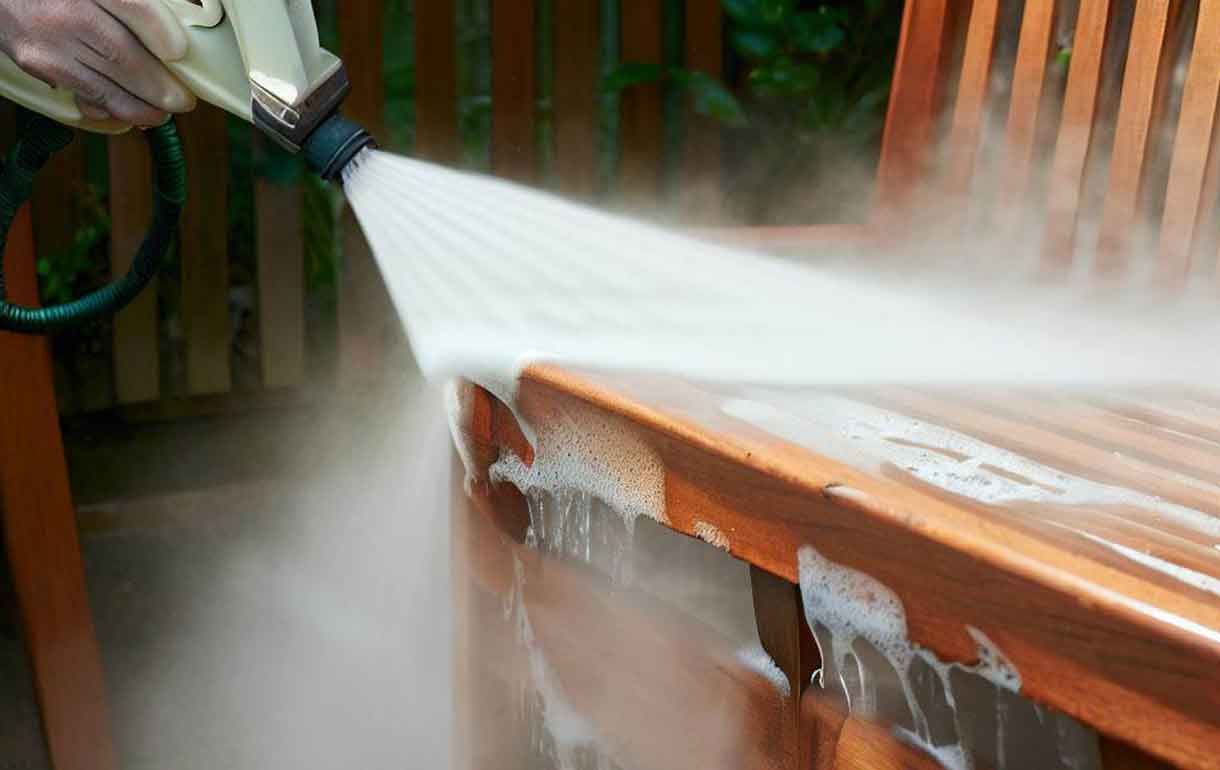
The trick is not to let any kind of dirt - food, drink, mud, pet poo - stay on your furniture long enough for a stain or mould to develop which will be more difficult to remove.
Cleaning garden furniture in winter
Cleaning garden furniture in winter is essential to prevent a build-up of dirt, dust, and potentially mould. Before the worst of the winter weather begins, it's a good idea to thoroughly clean your furniture.
Start by wiping down surfaces with mild soap and water, paying close attention to crevices where dirt and debris might accumulate. Make sure to use a soft cloth or the soft side of a sponge, avoid anything abrasive.
For materials like aluminium or synthetic wicker, a quick hose down and light scrub should suffice. Wooden furniture, such as teak or acacia, may require a specialised cleaner to treat the wood - this is optional. Once cleaned, allow the furniture to dry completely to avoid mould or mildew from forming during storage. To speed up the drying process you could wipe away any excess water with a dry clean cloth or towel.
We always advise against leaving your cushions outdoors during winter months. These need to be brought inside and stored somewhere dry and off the ground. Popular places are garages, sheds, summer houses and lofts.
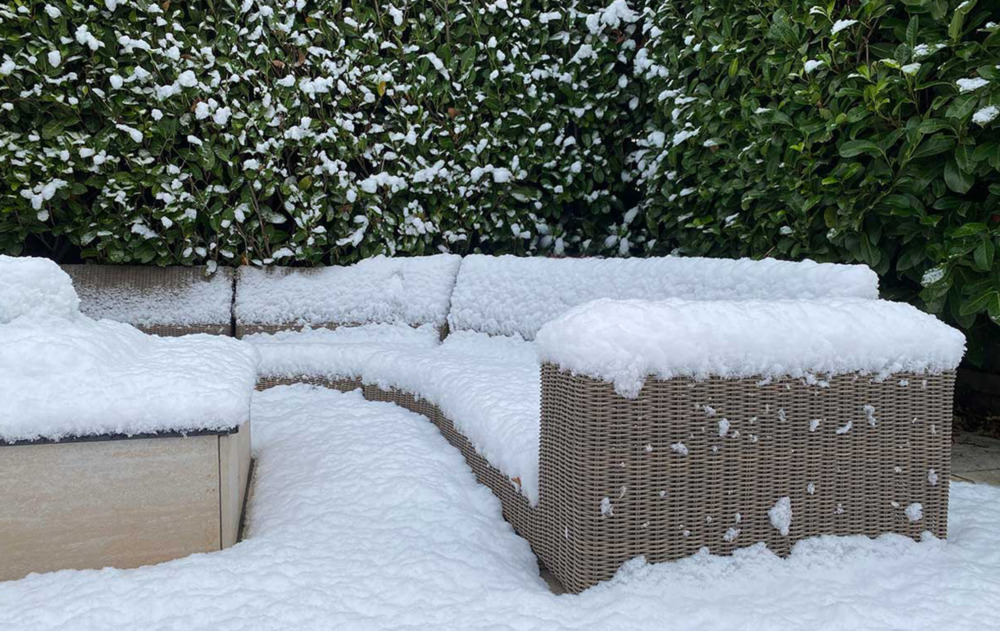
Protecting your furniture during winter is just as important as cleaning it. We recommend using protective covers, make sure the cover is breathable as well as weather resistant. For more information check out our blog on What To Do With Patio Furniture In Winter.
Cleaning garden furniture in spring
Spring is the perfect time to clean your garden furniture and prepare it for the sunny season after months of wet and icy weather. Once you have removed the protective furniture covers it is important to inspect your furniture to check for any areas that might require a bit more attention. Just like you did in winter, get your clean sponge, mild detergent and lukewarm water and begin cleaning down the frame and table tops.
Next, take your cushions out of storage and inspect them. If needed use a soft dry brush on the cushion covers to remove any dust. If your cushions have stained they can be hand washed using mild detergent and lukewarm water.
Once the furniture is clean, it's important to let everything dry completely in the fresh spring air before putting cushions back on or using the pieces. If you do not do this you risk trapping moisture and damaging your furniture.
Cleaning aluminium garden furniture
Cleaning aluminium furniture couldn't be any simpler! It’s a simple and low-maintenance task due to its rust-resistant properties, making it a popular choice for outdoor furniture. Just grab a dry clean cloth and warm soapy water then wipe down the furniture.
For a more thorough clean you could begin by using a hose, on a low setting, to gently rinse off any dust and debris. Then mix a solution of lukewarm water and mild soap and use a clean sponge or cloth to gently scrub the aluminium frame. Make sure to reach all areas, especially corners and joints, where dirt can accumulate.
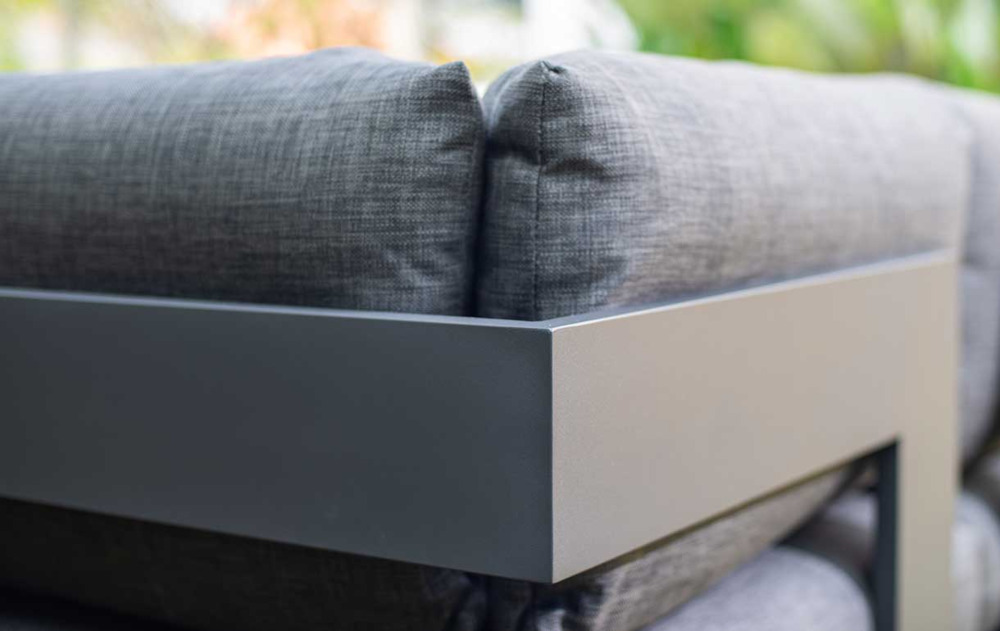
Avoid using harsh soap or abrasive sponges as these will damage the paint coating and potentially leave scratches on the powder-coated surface.
Once you have cleaned the furniture use the hose to remove any soapy residue then let the furniture air dry or use a cloth to speed this up.
Cleaning rattan garden furniture
You might think that cleaning rattan furniture is going to be a bit more fiddly because of all the grooves, but don’t worry it’s pretty straightforward.
Start by using a soft bristled brush or your vacuum with a brush attachment, and begin to remove any dust and debris from the crevices in the weave. Be thorough especially around any joints or tight corners where dirt will accumulate.
Then mix a solution of warm water and mild detergent - you can use dish soap. Dip a clean cloth or clean sponge into the soapy mix, wring it out slightly and begin to gently wipe the rattan weave. Work on a section at a time and pay attention to the tricky grooves. If you have some stubborn dirt you could use an old toothbrush to get into those tight spots.
Once you have scrubbed your furniture, it is important to remove all soapy residue. To remove the soap use your garden hose or a bucket of water. You may have seen people say to use a pressure washer, whilst this is possible we would always say to use the lowest possible setting to avoid damaging the rattan. Another piece of advice is to use the pressure washer at a distance to avoid damaging the rattan weave
Finally, let the furniture air dry or use a cloth to dry the rattan before adding the cushions and using the furniture. This is an important final step to prevent any mould or mildew from forming. If you want to use your furniture, drying it with a clean dry cloth will speed the process up.
Our easy-to-clean rattan garden furniture makes outdoor living hassle-free
Cleaning wooden garden furniture
Many people view wood as an awkward material but this is not true. Wood is incredibly durable and an excellent choice for garden furniture and the maintenance involved depends on the look you would like to achieve. Wooden garden furniture can be left alone, or uncovered, and it will mellow to a lovely silvery tone. Similarly, you will notice fine lines and cracks beginning to form. It is important to note that neither of these things impact the strength of wooden furniture, it is purely aesthetic.
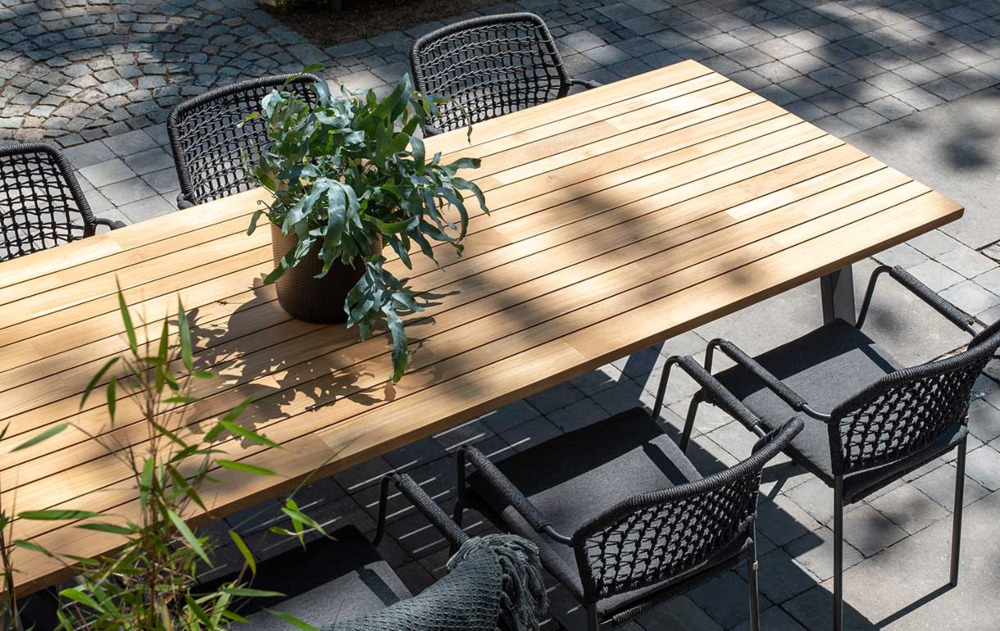
We would recommend that you leave wooden outdoor furniture uncovered, if you choose to cover the furniture it will begin to sweat underneath. This could lead to a build up of mould and mildew. However, if you do want to cover your furniture just make sure to periodically remove the cover and let the wood breathe.
One issue you may encounter is pesky bird droppings! Don’t panic, cleaning solutions are available such as teak cleaner to easily remove any stains from the surface of the wood. It is important to remove any stains as soon as you notice them so that they do not permanently mark the wood.
There are different treatments available which can change the colour of the wood, such as instant grey. These treatments can restore the wood to its original colour and should be used after cleaning the top.
If the top is marked with stubborn dirt you can lightly sand the surface. This will reveal the original colour of your furniture, we would recommend using a wood protector to seal the furniture after sanding.
Cleaning fabric garden furniture
All weather fabric furniture can be left outside all year either covered or uncovered. Start by using a soft brush or vacuum to remove any surface dust and dirt. Certain manufacturers will have cleaning kits available, it is important to check this as you do not want to use something that will damage the fabric. Cleaning kits can typically be used with a hose or pressure washer on a low setting.
For general cleaning, you can use warm water to remove any stains and spills. Make sure to do this as soon as possible to avoid having to do a deeper clean.
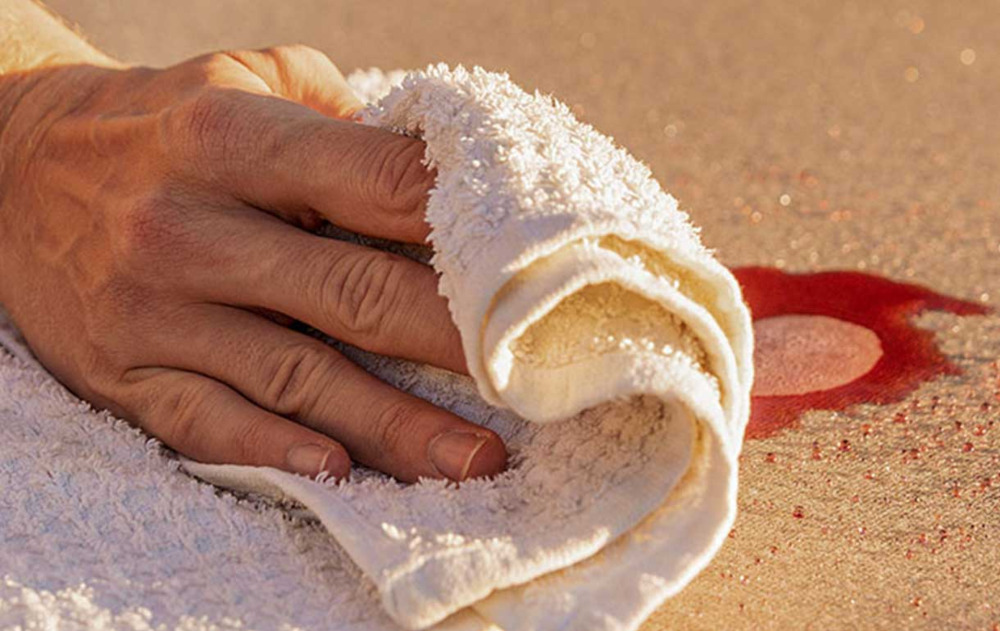
How often should I clean my garden furniture?
We recommend you clean your garden furniture once before storing it away in winter and then again at the start of spring.
However, you may need to clean your furniture more often during the summer months. This is because you are using your garden furniture more often so you might get more garden debris, food and spills on the furniture.
What do I use to clean my garden furniture?
All you need is lukewarm water and mild detergent to clean your furniture. Some materials might require specialist cleaning products. For example, if you have wooden furniture you might use a teak protector after cleaning your furniture.
Similarly, specialist kits can be sourced for cleaning outdoor fabric furniture. However, generally speaking, most garden furniture sets can be cleaned with lukewarm soapy water.
If you’re not sure whether to use a cleaning product or not, always check the manufacturer's care instructions before proceeding.
Here, we answer 5 of the most commonly asked questions regarding cleaning garden furniture:
1. What is the fastest way to clean outdoor furniture?
If the dirt is mild, you might get away with simply brushing it off. Otherwise, mix some mild detergent (eg washing-up liquid) with warm water in a bowl. Use a sponge or clean cloth to dab and wipe down the furniture. Then rinse your outdoor furniture thoroughly using another bowl of fresh warm water or a hose (but not a harsh jet spray). This should get rid of the majority of food and drink stains before you leave it to dry naturally. Once your furniture is dry, and you notice a few stubborn stains, repeat the washing process. Maybe use a soft brush to remove dirt caught in the corners or the weave of your rattan.
2. How do you clean patio furniture without a hose?
A few bowls of fresh warm water, together with a cloth or sponge, should be enough to rinse your patio furniture if you haven’t got a hose. Be sure to use enough fresh water to rinse off the soap so it doesn’t leave a mark or residue.
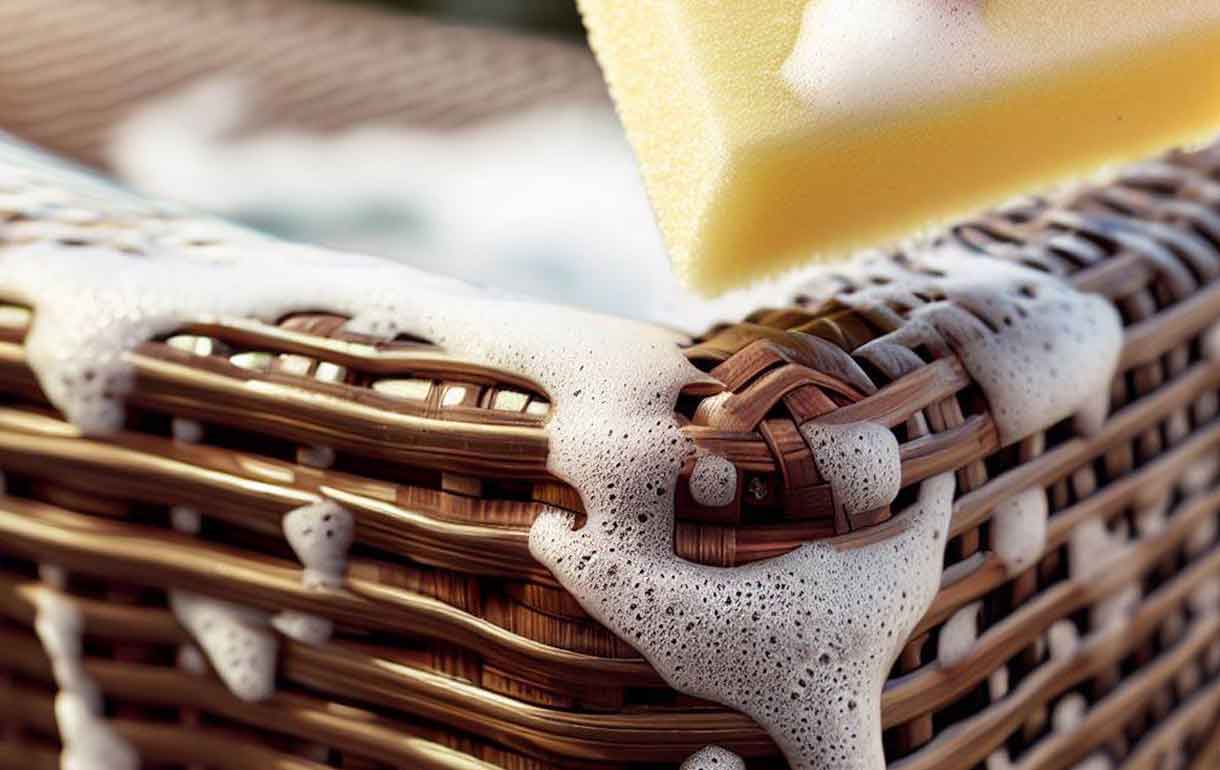
3. Will baking soda clean patio furniture?
Baking (or bicarbonate of) soda is often used to clean patio furniture. Before you use it, however, please check the furniture manufacturer’s cleaning instructions to see what they advise on stain removal. If you do go ahead and use baking soda to clean your patio furniture, test it out on a small area first just to make sure it’s going to work OK.
Using baking soda to remove stains is simple: mix a little of the soda with enough water to form a paste which you spread over the stain on your patio furniture. Let the paste stay undisturbed for around 15 minutes, then rinse it off thoroughly.
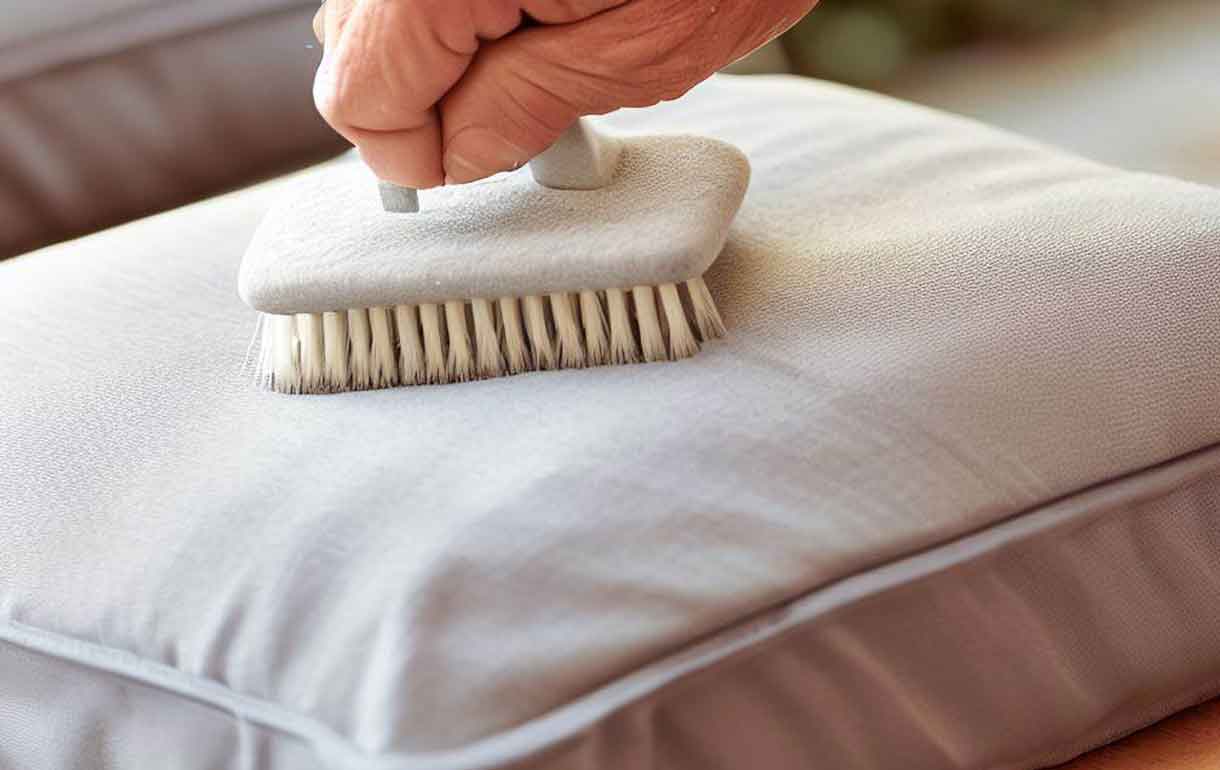
4. Can outdoor cushions be washed?
Check the manufacturer’s instructions first to see if your outdoor cushions can be washed. Some may be machine washable or might need more careful hand washing. If you’ve chosen weather-resistant cushions you should be able to just wipe or brush them clean. Whichever option you choose will be far more effective if you don’t leave food, drink spills or mud on your cushions for long. The sooner you act to remove stains, the less maintenance your garden furniture will cause you.
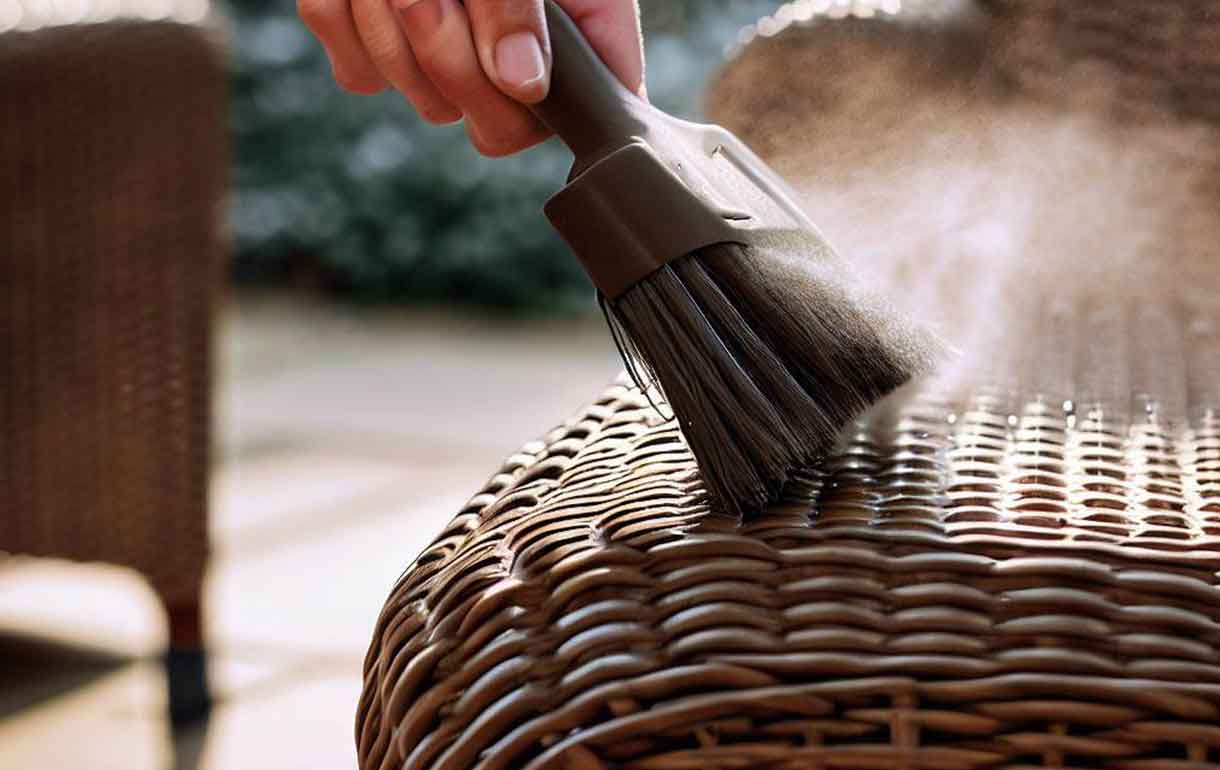
5. How do you get dust off patio furniture?
A soft brush (including on the end of a vacuum cleaner) might be sufficient to remove dust from patio furniture. If the dust has been on your furniture for some time, it’s likely to need cleaning off with a sponge soaked in a solution of mild detergent and warm water. Then rinse the furniture with fresh water, and leave it to dry naturally.
Keeping your outdoor furniture low maintenance
It’s absolutely possible to keep your outdoor furniture clean and in good condition with little effort on your part. Here’s a round up of our recommendations:
- Regular checking for dirt, and prompt removal to avoid stains
- Complying with the manufacturer’s cleaning instructions
- Careful cleaning – mild detergent or baking soda, warm water, soft brushes, vacuum cleaner, hose but careful with harsh jet sprays
- Thorough rinsing and drying – preferably naturally
- Care (covers or shade) during poor weather, and out of season
--------------------
Have further questions about different types of garden tables we stock? Our friendly, knowledgeable team are always on hand to help, just give us a call or visit one of our showrooms in Wakefield or Newcastle.
About the Author

Chloe Shaw is a Garden Furniture & Conservatory Furniture Specialist with many years of experience working at JB Furniture. Chloe combines her deep knowledge of garden furniture trends with her talent for creating engaging and informative content. She loves sharing inspiration, design tips, and product insights to help readers transform their gardens and conservatories into beautiful and inviting retreats.











